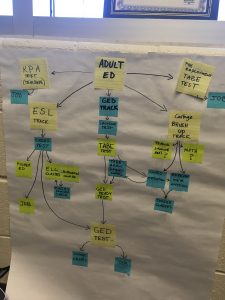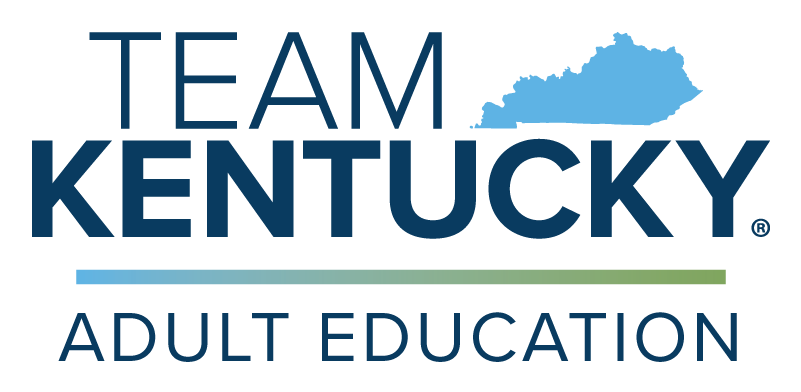
PRODUCT DESCRIPTION
The JCTC PLC analyzed the performance data and decided to focus on increasing enrollment because of the state level emphasis on enrollment and because increased enrollment could potentially impact other gains for performance measures. Following much discussion, the project was to connect with selected students with 0-11.99 hours that were identified by the instructional staff (students with the most potential to impact MSGs), and to transition those students to enrollment status (12+ hours). This would be done through repeated contacts with the students and by a crosswalk of students with probation and parole to encourage compliance. JCTC Skills U Director, with assistance from Data and Assessment Specialist, sent weekly reports (from KAERS) noting students that missed 1 week of class, 30 days, 60 days and 80 days. College and Career Navigators and instructors contacted students using multiple contact methods including but not limited to phone, social media, text, remind 101, etc. Instructors were also encouraged to use their professional judgement to contact students more often if considered appropriate. A collaborative google sheet for tracking student contacts was developed. There was a tab for each county. Some counties added items to the spreadsheet to make them more useful for that program.
A collaborative spreadsheet was created to record student contacts, notes about student contacts, and results. The staff successfully used the collaborative Google Sheet with tabs for each county and used professional judgement in determining the frequency of student contact efforts. Some program counties added data fields to improve their Sheet for their purposes. Tallied results showed 601 contacts of 184 students with 23% of the students contacted reengaging during the project period.

LIVE AND LEARN, MESSY MOMENTS
- There was duplication among data the career navigator is mandated to record on a different form than the one the PLC was using, as well as internal forms used by JCTC members for other purposes. Duplication, and recording the same data in multiple formats, is not just additional work but increases the likelihood of error. Programs should have the authority to adapt forms, such as that used by the career navigator, so that if it desirable to collect other information for program reasons they can do so on one form (provided the initial information required by the mandated form is collected)
- The necessity of an exact time for the PLC meetings made it difficult for some part time or alternatively scheduled instructors to attend the meetings.
- Protocols need to be developed for how frequently to contact students and the overall message (“we welcome you back”). The short timeline of the project and the intent to contact each student up to 7 times could be construed as harassment by some students. Instructors should always be able to rely on their professional judgement when making student contacts. A standardized checklist of student contact should be developed such as 24 hours after first visit write a welcome note, one week call or email, 4 weeks, 80 days
- Methods of student contact, such as cell phones, often disappear or become disabled.
- Partners are not doing their part to encourage or enforce compliance with participation. Additionally, mandated partners do not face the same threat of reduced funding that Kentucky Skills U programs do. One mandated partner actually stated that there are not any repercussions for the partner agency if their clientele did not participate. We need partners to have consequences regarding their participants so Kentucky Skills U can serve students efficiently.
- One difficulty of google docs has been inconsistent utilization of the spreadsheets; such as anonymous sign-ins making edits, etc. If there is more than person making the contacts, also include initials, time contacted, etc.
- If we are going to share documents, we need to have standards established. For example, uppercase/lowercase, font size and color. How to highlight things and so on.
The challenges are the temporary nature of the students contact points (phones, addresses, etc), and finding that fine line between encouragement and harassment. Preliminary findings are that out of 601 contacts of 184 students, 43 (23% of those contacted) reengaged to date. The unknown is if this number will increase in time and the staying power of the students that have returned. A big challenge is the staff time and effort required to contact the students.
As an interesting aside, some students would respond to some staff members but not others. As students built rapport and felt more comfortable with particular instructors, that trust helped to re-recruit students and re-engage them to successfully complete the program.

MASTERY MOMENTS
- Celebration is in order for the teamwork demonstrated by the PLC participants working together for the project.
- Everyone is more involved
- Some lives were changed.
- Students were made to feel welcome to return
- Student contacts were updated
- 23% of the contacted students returned.
- Liked keeping ongoing record of contacts.
- Our vision for using google docs has been right on and overall we seem to be adapting well to using Google Sheets.

WHAT DO WE NEED TO CLONE THIS PRODUCT?
- A list of students with less than 12 hours, from KAERS
- Crosswalk with Probation and Parole
- Spreadsheet (Google Sheets) for tracking or an Excel document uploaded to Drive

WHAT IS THE PROCESS?
- The Program Director and/or Career Navigators create a list of students with 0-11.99 hours from KAERS.
- Crosswalk the list with Probation and Parole for additional assistance for encouraging student engagement.
- Instructors review the student list to identify targets with the most potential to impact MSGs for contacts.
- Use or adapt the data collection spreadsheet provided or create your own to record student data regarding survey for students. Evaluate the possibility of collecting the data by modifying data spreadsheets already in use to avoid duplication of effort. Codes were used for Contacts (see Directions under Replication Documents).
- Share collaborative spreadsheets with all instructors, career navigators and others who will be contacting students.
- Career Navigators and Instructors contact students as many as 7 times encouraging re-engagement. The contact efforts are recorded, along with comments on the shared spreadsheet.
- Upon completion of the project, or at predetermined intervals (if it is ongoing), designate someone to compile and analyze the data.



